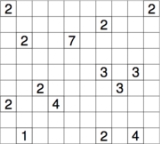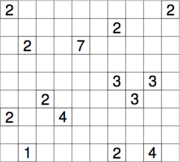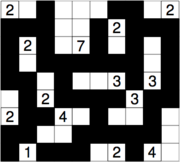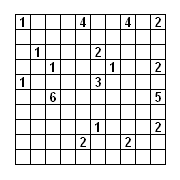
Nurikabe
Encyclopedia

Japanese folklore
The folklore of Japan is heavily influenced by both Shinto and Buddhism, the two primary religions in the country. It often involves humorous or bizarre characters and situations and also includes an assortment of supernatural beings, such as bodhisattva, kami , yōkai , yūrei ,...
that blocks roads and delays foot travel. Nurikabe was apparently invented and named by Nikoli
Nikoli
Nikoli Co., Ltd. is a Japanese publisher that specializes in games and, especially, logic puzzles. Nikoli is also the nickname of a quarterly magazine issued by the company...
; other names (and attempts at localization) for the puzzle include Cell Structure and Islands in the Stream.
Rules
The puzzle is played on a typically rectangular grid of cells, some of which contain numbers. Cells are initially of unknown color, but can only be black or white. Two same-color cells are considered "connected" if they are adjacent vertically or horizontally, but not diagonally. Connected white cells form "walls", while connected black cells form "a stream".The challenge is to paint each cell black or white, subject to the following rules:
- Each numbered cell is a wall cell, the number in it is the number of cells in that wall.
- Each wall must contain exactly one numbered cell.
- There must be only one stream, which is not allowed to contain "pools", i.e. 2x2 areas of black cells.
Human solvers will typically dot the non-numbered cells they've determined to be certain to belong to a wall, while trying to solve the puzzle.
Like most other pure-logic puzzles, a unique solution is expected, and a grid containing random numbers is highly unlikely to provide a uniquely solvable Nurikabe puzzle.
History
Nurikabe was first developed by "reenin (れーにん)," whose pen name is the Japanese pronunciation of "Lenin" and whose autonym can be read as such, in the 33rd issue of (Puzzle Communication) NikoliNikoli
Nikoli Co., Ltd. is a Japanese publisher that specializes in games and, especially, logic puzzles. Nikoli is also the nickname of a quarterly magazine issued by the company...
at March 1991.
It soon created a sensation, and has appeared in all issues of that publication from the 38th to the present.
As of 2005, seven books consisting entirely of Nurikabe puzzles have been published by Nikoli.
(This paragraph mainly depends on "Nikoli complete works of interesting-puzzles(ニコリ オモロパズル大全集)." http://www.nikoli.co.jp/storage/addition/omopadaizen/)
Solution methods

The greatest mistake made by beginning solvers is to concentrate solely on determining black or white and not the other; most Nurikabe puzzles require going back and forth. Marking white cells may force other cells to be black lest a section of black be isolated, and vice versa. (Those familiar with Go
Go (board game)
Go , is an ancient board game for two players that originated in China more than 2,000 years ago...
can think of undetermined cells next to various regions as "liberties" and apply "atari" logic to determine how they must grow.)
Basic strategy

- Since two islands may only touch at corners, cells between two partial islands (numbers and adjacent white cells that don't total their numbers yet) must be black. This is often how to start a Nurikabe puzzle, by marking cells adjacent to two or more numbers as black.
- Once an island is "complete"—that is, it has all the white cells its number requires—all cells that share a side with it must be black. Obviously, any cells marked with '1' at the outset are complete islands unto themselves, and can be isolated with black at the beginning.
- Whenever three black cells form an "elbow"—an L-shape—the cell in the bend (diagonally in from the corner of the L) must be white. (The alternative is a "pool", for lack of a better term.)
- All black cells must eventually be connected. If there is a black region with only one possible way to connect to the rest of the board, the sole connecting pathway must be black.
- All white cells must eventually be part of exactly one island. If there is a white region that does not contain a number, and there is only one possible way for it to connect to a numbered white region, the sole connecting pathway must be white.
- Some puzzles will require the location of "unreachables"—cells that cannot be connected to any number, being either too far away from all of them or blocked by other numbers. Such cells must be black. Often, these cells will have only one route of connection to other black cells or will form an elbow whose required white cell (see previous bullet) can only reach one number, allowing further progress.
Advanced strategy
- If there is a square consisting of two black cells and two unknown cells, at least one of the two unknown cells must remain white according to the rules. Thus, if one of those two unknown cells (call it 'A') can only be connected to a numbered square by way of the other one (call it 'B'), then B must necessarily be white (and A may or may not be white).
- If an island of size N already has N-1 white cells identified, and there are only two remaining cells to choose from, and those two cells touch at their corners, then the cell between those two that is on the far side of the island must be black.
Related puzzles
The binary determination puzzles LITSLITS
LITS, formerly known as Nuruomino , is a binary determination puzzle published by Nikoli.-Rules:LITS is played on a rectangular grid, typically 10×10; the grid is divided into polyominoes, none of which have fewer than four cells...
and Mochikoro, also published by Nikoli
Nikoli
Nikoli Co., Ltd. is a Japanese publisher that specializes in games and, especially, logic puzzles. Nikoli is also the nickname of a quarterly magazine issued by the company...
, are similar to Nurikabe and employ similar solution methods. The binary determination puzzle Atsumari
Atsumari (puzzle)
Atsumari is a binary-determination puzzle that was originally developed by Quadratic Games for the iPhone platform. The puzzle is played on a hexagonal grid. A rectangular board shape is standard but variations to the board shape can be part of the puzzle design. The puzzle starts with a subset...
is similar to Nurikabe but based upon a hexagonal tiling rather than a square tiling.
See also
- MinesweeperMinesweeper (computer game)Minesweeper is a single-player video game. The object of the game is to clear an abstract minefield without detonating a mine. The game has been written for many system platforms in use today....
- HashiwokakeroHashiwokakeroHashiwokakero is a type of logic puzzle published by Nikoli. It has also been published in English under the name Bridges or Chopsticks...
- List of Nikoli puzzle types

